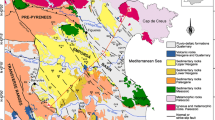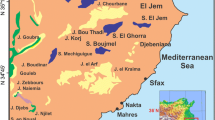Abstract
Dissolved Pb in 32 wells associated with corroding submersible pumps is examined within a rural water district after almost 20 years (1984–2002). Groundwater Pb ranged from 0.4–24.9 μg L−1 after 24 h pump flushing. Preliminary geochemistry and representative borehole lithology examinations were extrapolated by Markov chain modeling. The first-order geostatistical realizations of glacial sediments coupled with the Monte Carlo Metropolis-Hasting method suggest that elevated trace Pb persists in sand and gravel units, and continues at least to 40 m depth in the catchment. The 207Pb/206Pb and 208Pb/206Pb isotope compositions of groundwater Pb were decisive in discriminating the importance of leached Pb from submersible pump materials among geogenic sources.










Similar content being viewed by others
References
Alam SO, Edmonds JW, Hom T, Nicolosi JA, Scott B (1989) A reference database retrieval System: information as a tool to assist in XRD phase identification. Adv X-Ray Anal 32:545–550
Bacon JR, Berrow ML, Shand CA (1995) Isotopic characterization of lead in the Scottish upland environment. Int J Environ Anal Chem 59:253–264
Birden H, Calabrese J, Stoddard A (1985) Lead dissolution from soldered joints. J Am Water Works Assoc 77:66–70
Cheng Z, Foland KA (2005) Lead isotopes in tap water: implications for Pb sources within a municipal water supply system. Appl Geochem 20:353–336
Davis JC (1996) Statistics and data analysis in geology. Wiley, New York
Elfeki AM, Dekking M (2001) A Markov chain model for subsurface characterization: theory and applications. Math Geol 33:569–589
Eusden JD, Gallagher L, Eighmay TT, Crannell BS, Krzanowski JR, Butler LG, Cartledge FK, Emery EF, Shaw EL, Francis CA (2002) Petrographic and spectroscopic characterization of phosphate-stabilized mine tailings from Leadville, Colorado. Waste Manage 22:117–135
Galer SG (1999) Optimal double and triple spiking for high precision lead isotopic measurement. Chem Geol 157:255–274
Gelman A, Rubin DB (1992) Inference from iterative simulation using multiple sequences. Stat Sci 7:457–511
Gulson BL, Law AJ, Korsch MJ, Mizon KJ (1994) Effect of plumbing systems on lead content of drinking water and contributions to lead body burden. Sci Total Environ 144:279–284
Haario HE, Saksman E, Tamminem J (2001) An adaptive Metropolis algorithm. Bernoulli 7:223–242
ISO (1997) Determination of gold in jewellery alloys, cupellation method (fire assay). International Society of Standards no. 11426
Ludwig KR (1980) Calculation of uncertainties of U-Pb isotope data. Earth Planet Sci Lett 46:212–220
Metropolis NA, Rosenbluth AW, Rosenbluth MN, Teller AH, Teller E (1953) Equations of state calculations by fast computing machines. J Chem Phys 21:1087–1092
McNeill LS, Edwards M (2002) Phosphate inhibitor use at US utilities. J Am Water Works Assoc 94:57–63
Murphy E (1993) Effectiveness of flushing on reducing lead and copper levels in school drinking water. Environ Health Perspect 101:240–241
Neil CD (1999) Significant sand and gravel aquifers of the North Pownal quadrangle, Maine, Maine Geologic Survey Maine OF-Map 99–25
Page A, Sidle WC (1985) Trace metal evaluation of groundwater resources associated with crystalline complexes, Maine-New Hampshire region: vol 1. US Department of Energy Technical Report USDOE-85-051
Peters N J, Davidson CM, Britton A, Robertson S J (1999) The nature of corrosion products in lead pipes used to supply drinking water to the City of Glasgow, Scotland, UK. Fresenius J Anal Chem 363:562–565
Pocock S (1980) Factors influencing household water lead: a British national survey. Arch Environ Health 34:120–124
Poimes C, Cocherie A, Guerrot C, Marcoux E, Lancelot J (1998) Assessment of the precision and accuracy of lead-isotope ratios measured by TIMS for geochemical applications: example of massive sulphide deposits (Rio Tinto, Spain). Chem Geol 144:137–149
Rabinowitz MB (2002) Isotopic characterization of various brands of corroding grade refined lead metal. Bull Environ Contam Toxicol 69:501–508
Ross SM (2002) Introduction to probability models. Academic, New York
Shanklin DE, Sidle WC, Ferguson ME (1995) Micro-purge low flow sampling of uranium-contaminated ground water at the Fernald Environmental Management Project. Ground water monitoring and review summer, pp 168–176
Schock MR, Neff CH (1988) Trace metal contamination from brass fittings. J Am Water Works Assoc 80:47–56
Sidle WC, Roose DL, Barndt P (2001) Isotopic evaluation of Pb occurrences in the riverine ecosystems of the Kankakee watershed, Illinois-Indiana. J Am Water Resources Assoc 37:379–393
Tera F, Wasserburg GJ (1975) Precise isotopic analysis of lead in picomole and subpicomole Quantities. Anal Chem 47:2214–2220
Tessier A, Campbell PC, Bisson M (1979) Evaluation of the APDC-MIBK extraction method for the atomic absorption analysis of trace metals in river water. Int J Environ Anal Chem 7:41–54
Toner RN, Frost CD, Chamberlain KR (2003). Isotopic identification of natural vs. anthropogenic sources of Pb in Laramie groundwaters, Wyoming, USA. Environ Geol 43:580–591
Turekian KK, Wedepohl KH (1961) Distribution of the elements in some major units of the Earth’s crust. Geol Soc Am Bull 72:175–196
USEPA (2005) United States environmental protection agency standard methods. http://www.epa.gov/Standards.html. Cited 14 July 2006
Webster RK (1960) Mass spectrometric isotope dilution analysis. In: Smales AA, Wager LR (eds) Methods in Geochemistry. Interscience Publishers, New York, pp 202–246
Weissmann GS, Fogg GE (1999) Multi-scale alluvial fan heterogeneity modeled with transition probability geostatistics in a sequence stratigraphic framework. J Hydrol 226:48–65
Williams JS, Tepper DH, Tolman AL, Thompson WB (1987) Hydrogeology and water quality of significant sand and gravel aquifers in parts of Androscoggin, Cumberland, Cumberland, Oxford, and York counties, Maine. Maine geologic survey OF report 87–1a
Acknowledgements
Research is funded in part by an internal United States Environmental Protection Agency program development of watershed studies. The cooperation of Maine Public Health is appreciated. Thanks to M. Cvetic of Groundwater Research Co., Lewistown for effecting the field logistics. Also without the full cooperation of homeowners across Cumberland County this research would not be possible. Special thanks are given to the field crews through the years to complete an uninterrupted sampling record through all seasons. Thanks to the USEPA Isotope Hydrology Laboratory (Cincinnati); R. Johnson, Dartmouth University; P. Barndt, Oak Ridge National Laboratory; and D. Allen, USEPA (Cincinnati). Any opinions expressed in this paper are those of the author and do not, necessarily, reflect the official positions and policies of the USEPA. Any mention of products or trade names does not constitute recommendation by the USEPA.
Author information
Authors and Affiliations
Corresponding author
Rights and permissions
About this article
Cite this article
Sidle, W.C. Diagnosis of trace Pb in domestic wells, Upper Gloucester Catchment, Maine, USA. Environ Geol 52, 51–62 (2007). https://doi.org/10.1007/s00254-006-0448-1
Received:
Accepted:
Published:
Issue Date:
DOI: https://doi.org/10.1007/s00254-006-0448-1




